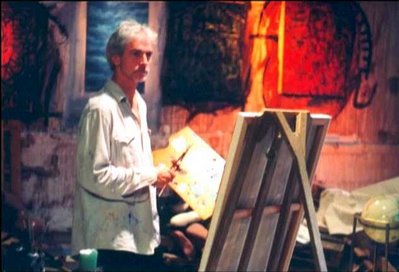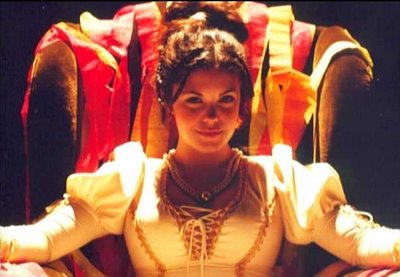THE WEIRD TALE COLLECTION, VOLUME 1:
THE YELLOW SIGN AND OTHERS
2001-03, Lurker Films, DD 5.1/2.0/16:9/LBX/+, $15.95, 100 minutes (approx.), DVD-5
Lurker Films, the Portland, Oregon-based company behind some well-received compilations of short films based on the works of H.P. Lovecraft and Edgar Allan Poe, here branch out into different avenues of short form horror with the first offering in a new series, "The Weird Tale Collection." While this disc has some unfortunate presentational faults, the films it collects are worth checking out, made with intelligence and subtlety and show a connoisseur's appreciation for the genre's history and what's best in it.
The program consists of Aaron Vanek's "The Yellow Sign" (2001, 45m 28s), David Leroy's "Tupilak" (2002, 13m 17s), Emilio Guarneri's "Il re giallo" ("The King in Yellow," 2003, 6m 20s), and a 15m profile of weird tales author Robert W. Chambers by French literary scholar Christophe Thill. The films are presented in a variety of formats and different aspect ratios, with "Tupilak" (the only 35mm contribution and the only anamorphic entry) looking the best of the bunch. The disc is best enjoyed on a standard video monitor.
Inspired by THE KING IN YELLOW by Robert W. Chambers, an early collection of dark metafiction that H.P. Lovecraft counted among his most influential readings, "The Yellow Sign" is a contemporary story about a young gallery worker, Tess (Shawna Waldron), who seeks out the reclusive artist Aubrey Scott (Dale Snowberger) to request an exhibition after having a series of nightmares about his work. Scott, who lives in a dank studio surrounded by his disturbing works, agrees to her request on the condition that she pose for him -- an exercise in stillness and concentration that makes her increasingly aware of something animated in a canvas hung on the wall behind the artist... a "yellow sign." Incisively scripted by John Tynes, the film is a good deal more engrossing than most MASTERS OF HORROR episodes, unsettling the viewer with words, ideas, and intimations of other dimensions lurking on the periphery of reality rather than bloodshed. It's well acted by the two principals and disappointed only by one unfortunate scene in which the Sony DV camerawork becomes so busy for its own sake that it upstages the action it should be representing. THE MONSTER SQUAD director Fred Dekker served as associate producer on this project. "The Yellow Sign" is offered in a choice of DD 5.1 or 2.0 audio with a variety of subtitle options, with numerous supplements, including outtakes, "normal" and "profane" audio commentaries, Snowberger's audition tape, and a slideshow.

Dale Snowberger as deranged artist Aubrey Scott in "The Yellow Sign."
Christophe Thill's "Chambers in Paris" documents the years which American author Robert W. Chambers spent in Paris, France, which yielded his obscure masterpiece of terror, THE KING IN YELLOW. For those familiar with the book, Thill's research is a treat as he videocams various authentic locations described in the novel and shows how they look today, which lends a verisimilitude to the fiction that Chambers would have surely appreciated.
"Tupilak," in French with English subtitles and filmed in a two-perf pulldown process called "Multivision 235", concerns the role played by an Inuit avenging spirit in the guilt suffered by two men (one of them played by writer-director David Leroy) who abandoned a dying man during an Arctic expedition. The story is predictable and a bit thin, but the acting is sincere and the film itself is opulently produced, to the extent of a grandiose score performed by the Hungarian Symphony Orchestra. It would be interesting to see such resources and commitment applied to a more ambitious story.
Despite its title, "Il re giallo" is less an hommage to Chambers' THE KING IN YELLOW than a revisitation of the zombie hospital action of Lucio Fulci's THE BEYOND, redone with lots of digital herky-jerky J-horror scare effects.
Lurker Films promises that the problem will be fixed with the second pressing but, unfortunately, this is no incentive to buy the current, flawed pressing. This is regrettable because it prevents me from more enthusiastically endorsing THE YELLOW SIGN AND OTHERS, whose seriousness, intelligence, and literary grounding are otherwise a breath of fresh air in the "tits and blood" arena of DTV horror. It's a series (and approach) I would like to see continue, and graduate to even better things. In the meantime, I think I'll track down some books by Robert W. Chambers.
